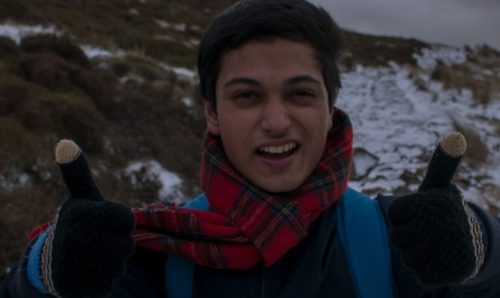From Project to Peer Reviewed Journal: Kamil’s experience
Research and impact The next step 13th September 2022
After completing his studies, UoM geology graduate, Kamil Kosiorek has recently had his outstanding fourth year project featured in Geosciences, an internationally respected open access journal. We caught up with him to discuss his experience, and say congratulations!

Choosing Geology
After growing up in Poland and Bradford, Kamil originally applied to study Physics at Manchester as one of his choices. Once accepted He studied Physics for two years, before realising that it was not for him and that he would prefer to do Geology.
“I wanted to do this because Geology allowed me to combine my interest in many sciences, and was less theoretical than Physics. I was able to go on field trips, which I enjoyed immensely despite the sad cancellation of some due to covid.”
“When it came to choosing my project, I met with Dr Ernest Rutter to discuss his work, and it seemed interesting. What initially attracted me was the fact it involved a lot of maths, processing, and data analysis skills that I had gained from my background in Physics.”
He was tasked with exploring how marble deforms under pressure by creating a more accurate method of analysing the crystal structure of these rocks.
The project

Electron backscatter diffraction (EBSD) is used to measure the ways in which the orientation of crystals in the calcite material of the rocks differ, and therefore can be used to measure the extent to which they have deformed under pressure. This is an analytical technique which involves concentrating an electron beam at a sample and measuring the pattern in which electrons pass through the material, diffract, and scatter onto a specialist phosphor screen.
In the past, it has been very hard to pick up smaller twins with this technique, which are very thin (some only a few micrometres in thickness, or even less!). Kamil explains more about the purpose of the project:
“Previously we were only limited to analysing the thicker twins. In order to extract data of the smaller twins, I took advantage of the fact that smaller twins can only be in one of three possible orientations in relation to the main crystal. Therefore, we could use EBSD to get the orientation of this bigger crystal, and develop a model that could predict all three locations/different solutions possible, and then project them onto the backscatter images we had. We were then able to match up the possible orientations with what we could actually see, and extract much more data. (as much as 700% more!)”
The technique could also be used to tell calcite twinning apart from other similar crystal deformation mechanisms, and discount those that were similar but not relevant to our study.
The projects applications

There still needs to be more work done to find a strong link between the effect of pressure experienced by these rocks and their deformation. If confirmed, this will be applicable to study areas such as the valleys of Karakorum in the Himalayas where the only exposed rocks are calcite rocks.
“It will be useful in similar kinds of analysis where we are looking for very thin features which cannot be measured directly. We will be able to take advantage of these methods in crystallography due to the predictability of certain elements.”
From project to peer-reviewed journal
“Dr Ernest Rutter has been working on this project for a long time, it was submitted to Geoscience and went through peer review. Ernest was approached by the journal regrading the publications special edition on twinning.”
The write up of the project was then subjected to a process of peer review, which meant revisiting the project in light of the suggestions of colleagues in the wider Geoscience community.
“This was a very scary process! There was lot of feedback, but the suggestions were constructive and helped us get the write up into the best condition it could be.”
“The methods we used were good, but they were lots of ways that we could improve the presentation, especially for those who hadn’t been working so closely on the project for so long!”
Breaking new ground
Kamil is now working as an Assistant Geologist/Engineer at SOCOTEC. Projects he works on include ground investigation, ground monitoring and core logging.
“The things I learnt during my degree definitely prepared me for the work I do now. Although sometimes the Geology we care about at The University is slightly different to the focus of the construction industry, there is a big overlap in the skills required.”
“In particular I was able to talk about my extended work on this project when I was interviewed for the role”
Advice for those interested in geoscience
Kamil provides some advice for those interested in pursuing geoscience at degree level and beyond:
“Learn some programming! It makes your work 10 times easier and frees you up to really focus your efforts.”
“Computer modelling will also become more and more important to the field as time goes on. It’s important to know the paper methods for the background of the science, but computer methods allow you to complete your work more precisely. I also make use of these skills all the time in my role. I also think you should pick Dr Ernest as your supervisor!”
“One more thing, I miss Manchester! I’ve travelled to quite a few places for work, and I liked Manchester the best.”
Check out our blog to hear more about the achievements of other alumni in our Department.
calciteGeologygraduatejournalmarblepublishtwinningundergraduate




Leave a Reply